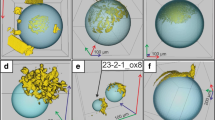Abstract
The fate of pre-eruptive bubbles depends largely on their buoyancy, which can be strongly modified by the presence of crystals attached to the bubble–melt interface. We define the attachment energy and attachment force as those resulting from the attachment of a crystal to a bubble. The attachment energy is such that (1) attachment of crystals to bubbles is always favored energetically, and (2) oxide minerals attach to bubbles much more strongly than silicates, because the attachment energy is a strong function of the wetting angle. Attaching crystals to bubbles can cause bubble–crystal pairs to become neutrally buoyant. There is a critical bubble radius below which the attachment force will be strong enough to keep the pair together; we show that crystals as large as 1 mm in diameter can form neutrally buoyant pairs. For early erupted Bishop magma, if all magnetite forms neutrally buoyant pairs with gas bubbles, ca. 0.1–0.2 vol% gas can be stored in the magma; 2–3 vol% of gas can be accounted for if all minerals form neutrally buoyant aggregates. These values are an order of magnitude lower than what is inferred from melt inclusions. Hence, both magnetite-free and magnetite-rich bubbles might have existed, but only a very small fraction of them could have been neutrally buoyant. Importantly, an intrinsic association between magnetite crystals and bubbles is expected. However, most magnetite crystals in the early erupted Bishop are free of bubbles; the puzzling conclusion is that nucleation away from crystals is favored over heterogeneous nucleation on crystal substrates.








Similar content being viewed by others
References
Adamson AW, Gast AP (1997) Physical chemistry of surfaces. Wiley, New York, p 784
Anderson AT (2006) Bubbleless glass pockets and natural bubble nucleation in rhyolitic magma. Eos Trans AGU 87(52): Fall Meet Supplement, Abstract V43A–1785
Boucher EA, Jones TGJ (1981) Empirical criteria for the flotation of a solid sphere at an interface in a gravitational-field. J Colloid Interface Sci 83(2):645–648
Gualda GAR (2006) Crystal size distributions derived from 3D datasets: sample size versus uncertainties. J Petrol 47(6):1245–1254
Gualda GAR, Anderson AT (2007) Magnetite scavenging and the buoyancy of bubbles in magmas. Part 1: Discovery of a pre-eruptive bubble in Bishop rhyolite. Contrib Mineral Petrol 153(6):733–742
Gualda GAR, Rivers M (2006) Quantitative 3D petrography using X-ray tomography: application to bishop tuff pumice clasts. J Volcanol Geoth Res 154(1–2):48–62
Gualda GAR, Cook DL, Chopra R, Qin LP, Anderson AT, Rivers M (2004) Fragmentation, nucleation and migration of crystals and bubbles in the Bishop Tuff rhyolitic magma. T R Soc Edin Earth 95:375–390
Hurwitz S, Navon O (1994) Bubble nucleation in rhyolitic melts—experiments at high-pressure, temperature, and water-content. Earth Planet Sci Lett 122(3–4):267–280
Laporte D (1994) Wetting behavior of partial melts during crustal anatexis—the distribution of hydrous silicic melts in polycrystalline aggregates of quartz. Contrib Mineral Petrol 116(4):486–499
Mangan M, Sisson T (2000) Delayed, disequilibrium degassing in rhyolite magma: decompression experiments and implications for explosive volcanism. Earth Planet Sci Lett 183(3–4):441–455
Mangan M, Sisson T (2005) Evolution of melt-vapor surface tension in silicic volcanic systems: experiments with hydrous melts. J Geophys Res Sol Ea 110(B1)
Mangan MT, Sisson TW, Hankins WB (2004) Decompression experiments identify kinetic controls on explosive silicic eruptions. Geophys Res Lett 31(8)
Mysen BO, Richet P (2005) Silicate glasses and melts: properties and structure. Elsevier, Amsterdam, p 544
Rapacchietta AV, Neumann AW (1977) Force and free-energy analyses of small particles at fluid interfaces. 2. Spheres. J Colloid Interface Sci 59(3):555–567
Rapacchietta AV, Neumann AW, Omenyi SN (1977) Force and free-energy analyses of small particles at fluid interfaces. 1. Cylinders. J Colloid Interface Sci 59(3):541–554
Schafer FN, Foley SF (2002) The effect of crystal orientation on the wetting behaviour of silicate melts on the surfaces of spinel peridotite minerals. Contrib Mineral Petrol 143(2):254–261
Smith PG, van de Ven TGM (1985) The separation of a liquid–drop from a stationary solid sphere in a gravitational-field. J Colloid Interface Sci 105(1):7–20
Wallace PJ, Anderson AT, Davis AM (1995) Quantification of pre-eruptive exsolved gas contents in silicic magmas. Nature 377(6550):612–616
Wallace PJ, Anderson AT, Davis AM (1999) Gradients in H2O, CO2, and exsolved gas in a large-volume silicic magma system: Interpreting the record preserved in melt inclusions from the Bishop Tuff. J Geophys Res Sol Ea 104(B9):20097–20122
Weisstein EW (2007) Spherical Cap. From MathWorld–A Wolfram Web Resource. http://www.mathworld.wolfram.com/SphericalCap.html
Wilson L, Sparks RSJ, Walker GPL (1980) Explosive volcanic-eruptions. 4. The control of magma properties and conduit geometry on eruption column behavior. Geophys J R Astron Soc 63(1):117–148
Acknowledgments
We have benefited greatly from stimulating discussions with Alfred Anderson and Bruce Buffett. We would also like to acknowledge NSF support (EAR-0408707) to A. T. Anderson.
Author information
Authors and Affiliations
Corresponding author
Additional information
Communicated by T.L. Grove.
Electronic supplementary material
Below is the link to the electronic supplementary material.
410_2007_206_MOESM1_ESM.avi
Three-dimensional view of Sample F7–12; glass was suppressed for clarity. Magnetite crystals are shaded blue, feldspar red, quartz green, and vesicles yellow. Notice that most crystals are not attached to large vesicles. Small vesicles (< 50 μm) are suppressed from this view. Field of view is ca. 8 × 7 mm
Rights and permissions
About this article
Cite this article
Gualda, G.A.R., Ghiorso, M.S. Magnetite scavenging and the buoyancy of bubbles in magmas. Part 2: Energetics of crystal-bubble attachment in magmas. Contrib Mineral Petrol 154, 479–490 (2007). https://doi.org/10.1007/s00410-007-0206-8
Received:
Accepted:
Published:
Issue Date:
DOI: https://doi.org/10.1007/s00410-007-0206-8




